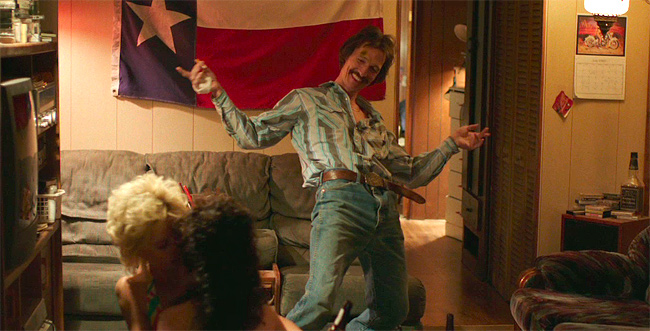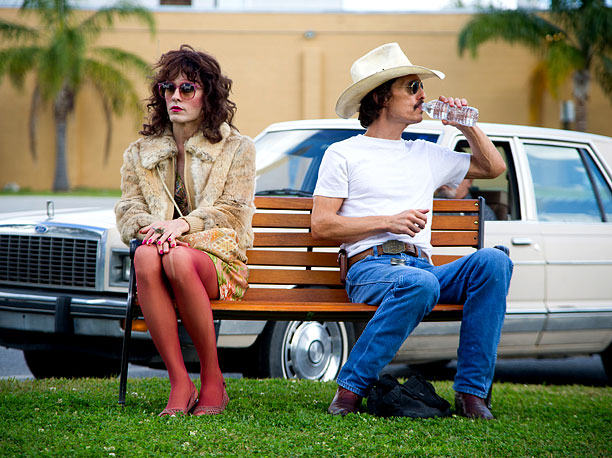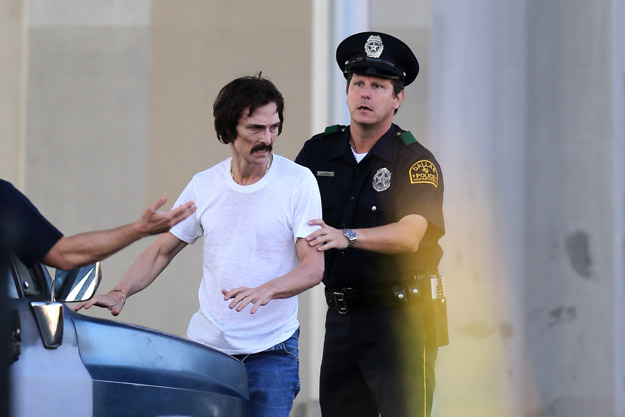
Dallas Buyer’s Club is a good movie built around an amazing performance. Mostly a by-the-numbers biopic, Dallas Buyer’s Club tells the story of Ron Woodruff (Matthew McConaughey) an alcoholic coke-head who fucks anything (with a vagina) that moves and works a menial job as an electrician when he isn’t bull ridin’ at the rodeo. After getting electrocuted at his job, Woodruff wakes up in the hospital to find two doctors (played by Alias’ Jennifer Garner and American Horror Story’s Denis O’Hare) covered in face masks that tell him he has been infected with HIV and has roughly thirty days to “get his affairs in order.” Woodruff goes into a homophobic rampage and claims nothing can kill Ron Woodruff, before storming out of the hospital.
As one could guess, Woodruff gets increasingly sicker and after his friends abandon him for having “faggot blood”, he realizes he has to seek help to survive. He returns to the hospital in hopes he can get his hands on the newly developed AZT, but Garner’s character informs him the drug is just getting ready for human trials and won’t be available for public consumption for another year. Faced with few options, Woodruff gets a hospital janitor to score him AZT. When that option dries up, he decides to partner up with a sympathetic junkie drag queen, Rayon (played by an almost unrecognizable Jared Leto) and import FDA-unapproved drugs into the U.S. from Mexico. With the help of his attorney (The Walking Dead’s Dallas Roberts), Woodruff and Rayon start the Dallas Buyers Club, where instead of selling the drugs they sell monthly memberships which come with free AIDS drugs. Of course, this creates tension with the FDA and law enforcement and the whole movie is basically Woodruff and his members fighting to survive against drug companies that are losing money.

Even if it isn’t groundbreaking or unpredictable, Dallas Buyer’s Club makes up for what it lacks in drama with a interesting history lesson of what AIDS prevention was like at a time when nobody really knew much about it. In the mid 1980s, AZT was the new drug thought to be patients best deterrent against AIDS, but doctors didn’t realize that the high dosage they were subscribing was potentially toxic and could even speed up the process. Also there were many Buyer’s Clubs all around the United States including one in New York and Florida, treating patients at lower rates than the ball-busting standard $10,000 a year AZT treatment hospitals were charging at the time. The film also borrows a lot of elements from Philadelphia, including the frightful way uninfected people acted around those diagnosed with HIV. It wasn’t yet common knowledge that if an AIDS patient spit on you, you had really nothing to worry about. It also wasn’t common knowledge that people other than homosexuals could contract the disease from activities such as intravenous drug use and even unprotected heterosexual sex.
From a filmmaking perspective, director Jean Marc Vallee does an adequate job here. Most of the shots have the claustrophobic indie film feel that Darren Aronofsky made famous. There is one completely unnecessary shot of a rodeo clown popping up from inside a trash can during one of Woodruff’s hallucinations. This seemed really out of place for me, and almost made me feel as if i was in a Fellini movie or something. The screenplay features a great arc for Woodruff’s character (his transition from homophobe to humanitarian is realistically gradual) but the screenplay completely limits every other character to being one-dimensional. This isn’t necessary, even for a character-study biopic, because multi-layered supporting characters add to the meat of the leading character. The screenplay does sport some solid and amusing dialogue, but the arc and progression of the story is very cliche for a biopic — character gets beaten down, character builds himself back up, character faces obstacles, character learns his flaws, character gets knocked down hard and then has to fight the final fight for his cause at the end. We’ve seen it all before in different packages, so we know what’s coming.

Then there’s Matthew McConaughey, who completely knocks it out of the park with this performance. Building up his respectable resume over the past two years with Mud, Magic Mike and especially Killer Joe, McConaughey gives us easily his most powerful, yet most subtle and nuanced performance here. Ron Woodruff never feels like McConaghey in a cowboy hat, the high-profile movie star is able to shed most of his charisma to play a cocky hillbilly with more smarts than you’d expect. Losing thirty pounds for the role, McConaughey looks like a sad dancing skeleton for most of the picture. In the other roles, the actors are mostly one-note and uninteresting, especially Jennifer Garner who isn’t given really anything to do with her character. Jared Leto is great in a painfully underwritten role as the junkie drag queen, and Steve Zahn as a Dallas police officer proves yet again he can do good dramatic work when he’s not trying to suck his own dick in shit like Saving Silverman.
Dallas Buyer’s Club is an intriguing bit of American history, but the real reason to see it is for Matthew McConaughey’s tour de force performance.
Grade: B